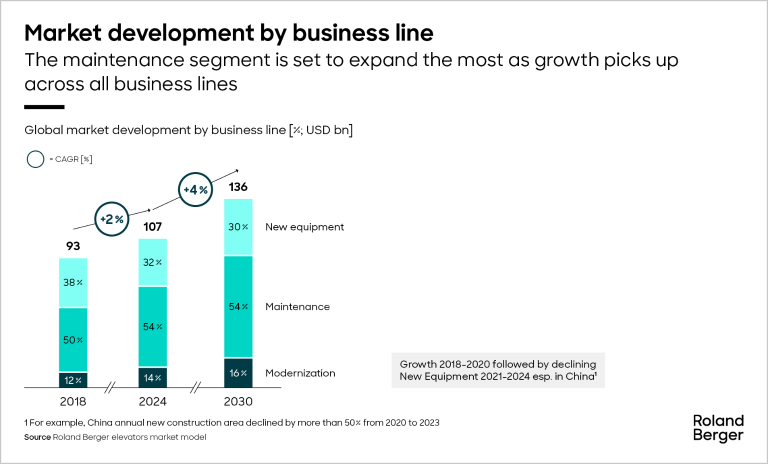Cultural intricacies and industry best practices within the elevator & escalator industry.


Elevator market outlook 2030
A regular comprehensive report and model of the elevator industry and its future
The USD 107 billion global elevator market has experienced several ups and downs in the past few years. After a period of strong growth between 2016 and 2021, the trajectory levelled out as the after effects of the COVID-19 pandemic and a construction crunch – particularly in China – took hold. Today, the picture is one of steady, rather than remarkable, growth.

"The elevator market remains attractive, driven by urbanization and a strong service business. While new equipment challenges persist in regions like Germany and China, they will eventually be overcome."
But what does the future hold? What trends are driving the elevator market, how will different regions and business lines perform in the coming years, and how will the big players fare against increasingly bullish smaller elevator companies? Such questions are not easily answered, and thorough and granular analyses of the market are currently limited. Roland Berger wants to change this. As such, we are launching a new, six-monthly report for the global elevator industry that provides comprehensive insight into the current and future global market.
Each report will fulfil several objectives. First, they will look at key drivers and trends in the market and assess their impact, from construction spending to growth and urbanization to digitalization and sustainability. Then, using our proprietary market model, the reports will break down the market to provide detailed analyses and growth forecasts by business line (new equipment, maintenance, modernization) and region for the next six years on a rolling basis. This includes assessments of market value and development, installed base, pockets of growth and competitive dynamics. In addition, when relevant, each report will include details of key dynamics in the elevator market.
A couple of examples help to underline the value of such data. Construction activity in China, one of the biggest elevator markets, is currently highly constrained due to the country’s credit crisis and real estate problems, as demonstrated by the collapse of the one of largest real estate developers. The new equipment business line is therefore currently performing poorly. But the service market is still growing strongly. Will this still be the case in six months’ time, or will the situation have reversed?
The model also provides an analysis of market shares of the big six elevator players (Otis, Kone, Schindler, TKE, Hitachi and Mitsubishi.) compared to their smaller competitors. Currently, their combined market value is stable in most regions. But will the picture be the same in 2030, or will the smaller companies have gained market share?
The Roland Berger Elevator Market Outlook reports aim to answer these questions and many others. The first edition is available to download now, or feel free to contact one of our industry experts for more information.
Summary of first report
The first edition of the Roland Berger Elevator Market Outlook, covering the period from 2018 to 2030, provides a benchmark for subsequent reports. It offers several key findings, including:
Business lines
New equipment: The number of new installations will decrease between 2021 and 2025 due to the construction downturn, which is driven by factors including oversupply in China, higher interest rates, disrupted supply chains and trend towards remote work. Recovery expected to take until 2030.
Maintenance: High growth is expected driven by the ever-expanding installed base.
Regions
Europe: Market size now approaching that of Asia; continuing growth due to large Maintenance market and above average Modernization market growth.
Asia: Negative downturn between 2022 and 2024 due to the fall in new installations. Growth expected to gradually pick up again in 2026.
North America: Modernization growing above average due to aging installed base. New equipment and Maintenance have slower growth compared to Asia and Europe.
Growth areas
Growth perspective: Modernization in Asia (11% CAGR 2024-30) and Maintenance and Modernization in Middle East & Africa (8% respectively 11% and 9% CAGR 2024-2030) are most promising due to aging installed base and construction growth.
Value perspective: Maintenance business in Europe (USD 7 billion growth potential by 2030) and Asia (USD 8 billion) comprise the most attractive areas.
Register now to access the full study, to learn more about the future of the global elevator industry.











